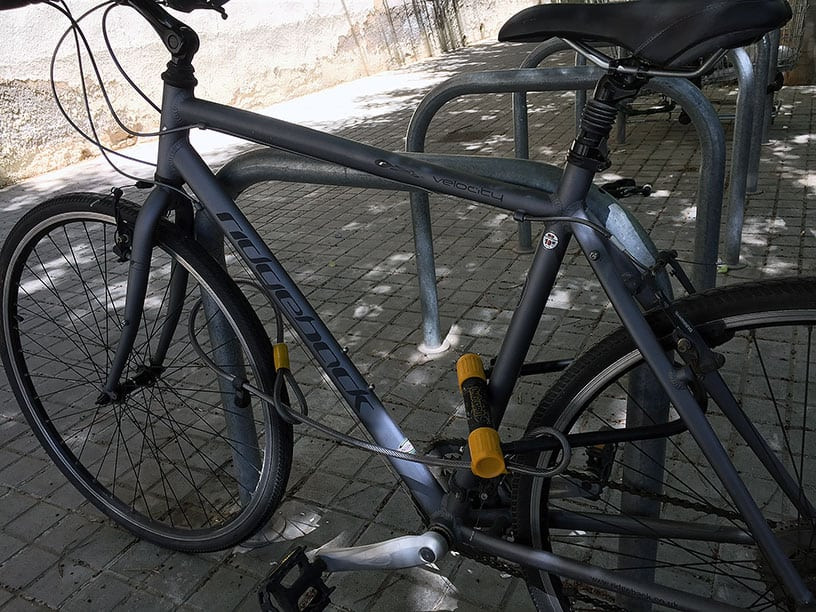A cable lock might appear to be a fantastic solution for securing your bicycle. They are inexpensive, lightweight, portable, and simple to wrap around your bike when you need to lock it up.
However, there’s one critical aspect where they fall dramatically short: security!
If there’s one undeniable truth in the realm of bicycle security, it’s this: securing your bike with just a cable lock is practically inviting theft. It’s not a matter of if it will be stolen, but when. So, please, promise yourself this one thing…
Never, under any circumstances, rely solely on a cable lock to protect your bike!
If you’re reading this because you’re considering buying a cable lock, I understand exactly where you’re coming from. I was once in the same boat.
As I recall, my thought process at the time went something like this: “My bike isn’t particularly valuable or eye-catching, so thieves probably won’t give it a second glance.” And also: “Surely, shops wouldn’t sell these locks if they weren’t at least reasonably secure?“
So, I purchased a cable lock for my brand-new bike. And, predictably, on the very first night I used it, my bike was stolen!
The harsh reality is that no bike is “too crappy” to be stolen, and the retailers who sell these flimsy locks are not invested in whether or not your bike remains yours.
Still not convinced? Perhaps you think I’m just trying to push you towards a more expensive lock? Let’s examine some real-world evidence with videos and crime statistics to solidify the point!
Witnessing Cable Locks Defeated by Thieves
Below are three videos showcasing actual thieves in action, effortlessly stealing bikes secured with cable locks. Of course, any lock can be overcome given the right tools and enough time. But observe just how incredibly easy cable locks make it for these criminals.
Some cable locks are so weak that a thief can simply use brute force to rip the bike free, no tools required…
 Thief ripping a bike cable lock with bare hands
Thief ripping a bike cable lock with bare hands
Here’s another instance where a thief uses a tiny pair of cable cutters to quickly snip through the lock. Fortunately, in this case, they are apprehended before they can make off with the bike…
 Thief cutting a bike cable lock with small cable cutters
Thief cutting a bike cable lock with small cable cutters
Thicker cable locks might seem more substantial, but they can still be defeated rapidly using slightly larger cable cutters or bolt cutters. The process remains quick and straightforward…
Crime Statistics Paint a Clear Picture: Cable Locks and Bike Theft
My warnings are not just based on anecdotal evidence; crime statistics consistently back up these claims. Numerous studies have demonstrated a significant correlation between using cable locks and a dramatically increased likelihood of bike theft. Consider this example:
Bike Thefts by Lock Type
Data compiled by the Harvard Police Department in 2011 revealed a stark reality: nearly two-thirds of all bicycles stolen were secured with cable locks. This overwhelming majority underscores the vulnerability of cable locks in real-world theft scenarios.
The Fundamental Flaw: Why Cable Locks Are So Insecure
Cable locks are constructed from multiple thin strands of steel encased within a plastic tube. It’s precisely this thinness of the steel strands that contributes to the lock’s lightweight nature, flexibility, and low cost (as less metal is used).
However, these thin strands are also the inherent weakness that makes cable locks so insecure. They can be effortlessly severed with common tools like cable cutters or bolt cutters. These tools essentially chew through the thin cables, one strand at a time, much like scissors cutting through hair!
While thicker cable locks might give a superficial impression of enhanced security, the truth is often deceptive. These “thicker” locks often primarily consist of a thicker plastic casing, with little to no significant increase in the amount of internal steel.
Rethinking Cable Locks: Can They Serve as Secondary Security?
The paramount advice remains: never use a cable lock as your primary means of securing your bicycle. By “primary security,” we mean the lock that directly fastens your bike frame to a stationary, immovable object in a public space or at home.
Many cyclists opt for a secondary lock, often as an additional layer of security for the frame or, more commonly, to secure the front wheel, seat, or both.
 U-lock and cable for bike security
U-lock and cable for bike security
These secondary locks sometimes take the form of thin cable lassos, often sold in combination with a primary U-lock. These lassos are designed to be used in conjunction with another lock, as they lack an independent locking mechanism.
Personally, I’m not a strong advocate for these cable lasso locks. They are incredibly easy and quick to snip through with even small handheld cable cutters.
Furthermore, I find them rather cumbersome to use. Their length and flexibility make them unwieldy to carry around, difficult to maneuver around your bike when locking up, and a hassle to untangle when you’re ready to ride.
Having said that, they are undeniably better than nothing at all. And if your bike is equipped with quick-release levers on the wheels or seat post, you absolutely need to protect these components with some form of security!
However, it’s crucial to understand and accept that a cable lock, even as a secondary measure, only provides minimal, superficial protection. If a thief is determined to steal your wheel or seat, a cable lock will not pose a significant deterrent.
Frankly, there are far more secure and user-friendly ways to protect your wheels and seat. I strongly encourage you to explore these alternatives before considering a cable lock for this purpose.
Key Takeaway: Ditch the Cable Lock
The most crucial message I want to convey across this entire website is this: please, do not rely on a cable lock to secure your bicycle!
If we collectively stopped using these ineffective locks on our bikes, bicycle theft rates would undoubtedly decrease significantly.
It’s understandable why cable locks are initially appealing. They promise so much convenience: super lightweight, easy to use and carry, and very affordable. But they utterly fail in their fundamental purpose: to genuinely protect our bikes from theft.
While it’s true that you won’t find another type of lock that perfectly replicates all the practical advantages of cable locks, you can find locks that offer some of those desirable qualities while also effectively fulfilling their primary function: preventing a thief from stealing your bike.
I recommend carefully considering which features of cable locks are most important to you and where you might be willing to compromise.
Then, utilize my simple three-step guide to finding a bike lock that is both convenient to use and genuinely capable of safeguarding your bike from theft!
More Good Stuff:
Best U-lock
Win a Free Bike!
How to lock your bike (properly)
